Latest news about our stars and galaxies this 2018.
I was looking at the sky from my window last week and I thus imagine what is really happening to our heavenly bodies. I decide to surf the internet to know about it and what’s happening up there. As we were being taught Stars are giant, luminous spheres of plasma. Galaxies consist of stars, stellar remnants, dust, gas, and dark matter, bound together by gravity. Learn more about stars and galaxies. Though they look serene and silent from our vantage on Earth, stars are actually roiling balls of violent plasma.
Supersize Stars May Be More Common Than Previously Thought
By Charles Q. Choi
The Tarantula Nebula, located about 180,000 light-years from Earth in the neighboring galaxy known as the Large Magellanic Cloud, hosts stars with the greatest masses yet detected. New research examining this nebula suggests massive stars are even more common than previously thought.
Credit: NASA, ESA, & F. Paresce (INAF-IASF), R. O'Connell (U. Virginia), & the HST WFC3 Science Oversight Committee
Heavyweight stars up to hundreds of times the mass of the sun may be more abundant than previously thought, a new study finds.
These findings suggest that black holes and other exotic remnants of dead massive stars may also be more common than previously suspected, and that supersize stars may have played a bigger role in the evolution of the universe than previously predicted ehmmm.
But astronomers have long known of stars that are more than 10 times the mass of the sun. The most massive star currently known, R136a1, is about 300 times the sun's mass.
Massive stars are behind many of the most dramatic events and exotic objects in the universe. For example, when massive stars die, they do so in outbursts known as supernovas, which can briefly outshine all of the other stars in the massive stars' galaxies. Wow interesting. In addition, the remnants of supernovas can include black holes and neutron stars. Supernova Photos: Great Images of Star Explosions
Furthermore, massive stars have played a major role in the evolution of the universe. For instance, stars are ultimately the source of the cosmos' "metals" — (what astronomers call elements heavier than helium) — and massive stars in particular contribute greatly to forging these "metals," study lead author Fabian Schneider, an astrophysicist at the University of Oxford in England.
In addition, it is nice to note that massive stars possess more fuel than smaller stars do, so they burn hotter, generating powerful radiation and strong winds of charged particles that can influence the fate of galaxies. Prior work suggested that such radiation played a key role in "the epoch of re-ionization," when the universe emerged from its dark ages.
Did you know that Right after the Big Bang, the universe was a rapidly expanding hot stew of ions, or electrically charged particles. About 380,000 years later, these ions cooled into neutral hydrogen gas. The universe stayed dark until gravity pulled matter together into the first stars. The intense ultraviolet light from this era caused this murky neutral hydrogen to ionize, and the gas has stayed in that state since that time. Once the universe became re-ionized, light could travel freely through space.
However, pinpointing exactly how important massive stars were to that transformation has proved tricky because of the difficulty in studying them. One reason for this is that massive stars are relatively rare — lower-mass stars are more common than higher-mass stars, Schneider said. Another reason is that massive stars have much shorter lives than lower-mass stars do, he added — because massive stars burn hot, they go through fuel quickly and die young. For instance, while the sun is about 4.6 billion years old and is expected to last another 5 billion years or so, the most massive stars may have lifetimes of only a few million years.
To shed light on the lives and deaths of massive stars, Schneider and his colleagues focused on the Tarantula Nebula, located about 180,000 light-years from Earth in the neighboring galaxy known as the Large Magellanic Cloud. This nebula hosts the stars with the greatest masses yet detected, including R136a1.
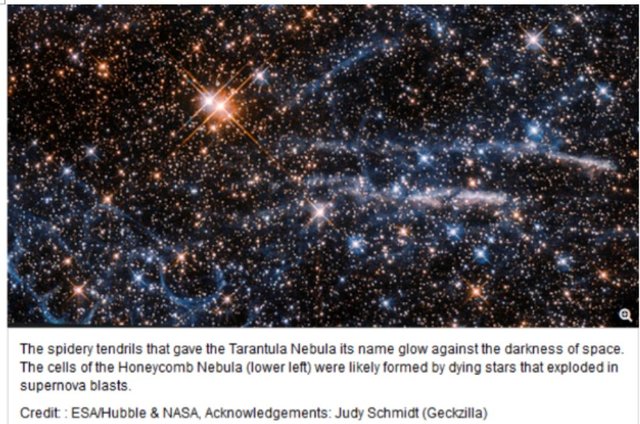
The scientists used the European Southern Observatory's Very Large Telescope in Chile to analyze the masses and ages of about 800 massive stars in the Tarantula Nebula. This area, also known as 30 Doradus or 30 Dor, is the largest star-forming region in the nearby universe that astronomers can analyze in great detail, Schneider said. At more than 1,000 light-years wide, if it were only about 1,300 light-years distant, like the local Orion Nebula is, it would be as wide as 60 full moons and shine bright enough to cast shadows on Earth. Wow!!!
The researchers looked at stars greater than 30 solar masses in size, discovering that about 30 percent more of these were born in the nebula than long-standing models of star formation would predict. This discrepancy grows larger at the highest masses, the researchers said.
"Once we realized that 30 Dor hosts many more massive stars than previously thought, we were baffled and thought that we did something wrong," Schneider said. "I would say this was to some extent a chance finding while we were aiming at other questions."
Some researchers suggested that prior estimates of the number of massive stars might be off because previous research focused mainly on stars of 30 to 40 solar masses or less. In contrast, Schneider and his colleagues examined large numbers of massive stars of up to 200 solar masses in size.
"In the past, it has been suggested that stars above 150 solar masses cannot form," Schneider said. But in light of the new study, "it seems likely that stars up to 200 to 300 solar masses can actually form."
There are two possible explanations for why there might be a greater number of massive stars than previously thought. One explanation is that the Tarantula Nebula has only 40 percent as much "metal" as the sun, and that lower metallicity can lead to a greater number of massive stars, Schneider said. Another is that the Tarantula Nebula is a so-called "starburst," a region with an extraordinarily high rate of star formation, and that previous generations of stars in the nebula may have heated the clouds in which later generations of stars are born, enabling the emergence of more massive stars, he added.
If massive stars make up more of the universe than previously thought, it could have a wide range of consequences across the cosmos, Schneider said. For instance, supernova explosions might happen 70 percent more often than previously thought, and the rate at which black holes form might be 180 percent greater than prior models predicted, he said. Supernovas might also give off three times as many elements as previously thought, he added.
Furthermore, massive stars could give off four times as much ionizing radiation as previously thought, Schneider said. "During the re-ionization of the universe, massive stars most likely played a big role because of their enormous ionizing radiation," he added.
Future research should analyze other star-forming regions to see if these new findings hold there as well, Schneider said.
The scientists detailed their findings in the Jan. 5 issue of the journal Science.
ii. The Most Amazing Space Photos last Week!
By SPACE Staff
Mesmerizing Clouds of Saturn
Brilliant hues of blue and gold are smeared across Saturn's cloud tops in this view from NASA's Cassini spacecraft. Citizen scientist Kevin Gill processed the image using near-infrared data that the spacecraft collected just before it passed through Saturn's ring plane in December of 2012.
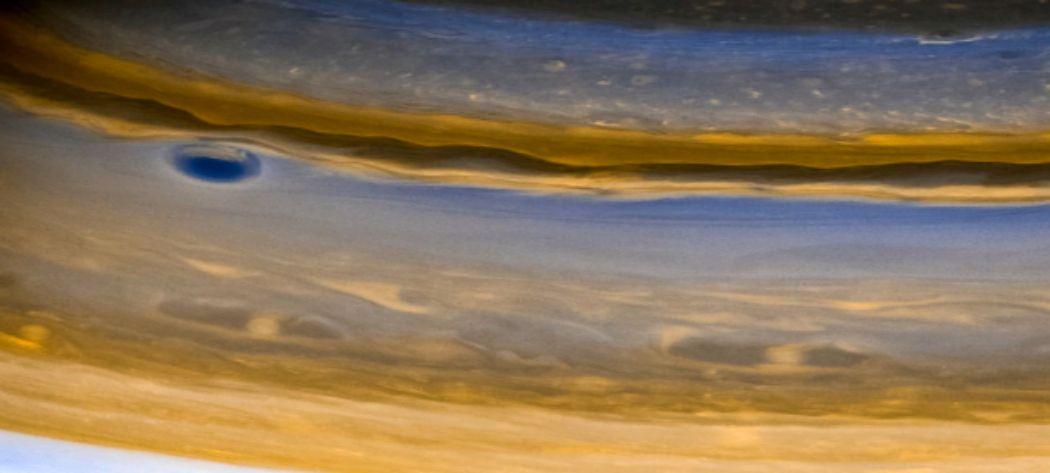
Credit: NASA/JPL-Caltech/SSI/Kevin M. Gill/Flickr
Boeing's Heat Shield Put to the Test
A heat shield for Boeing's new CST-100 Starliner space capsule undergoes qualification testing at the company's Huntington Beach Facility in California. The spacecraft will be used to ferry astronauts to and from the International Space Station as part of NASA’s Commercial Crew Program.

Credit: Boeing
Happy New Year from the International Space Station!
An international crew of three NASA astronauts, two Russian cosmonauts and one Japanese taikonaut celebrate the New Year at the International Space Station by sharing a meal in their festive (and matching) Expedition 54 T-shirts. Happy 2018 NASA.
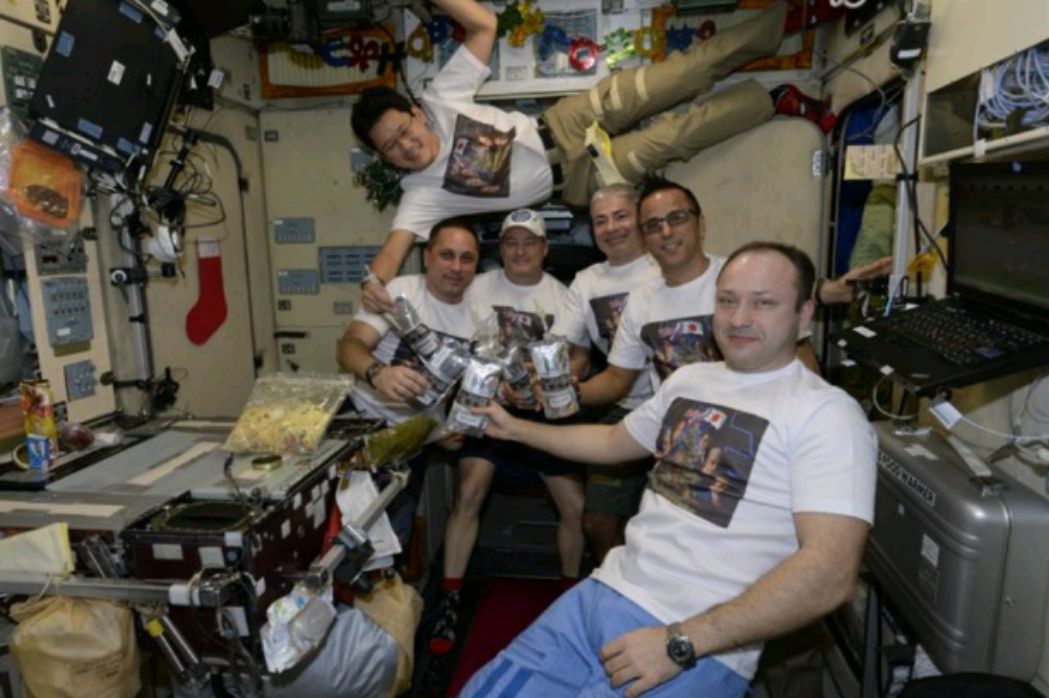
Credit: NASA/Joe Acaba/Twitter
A Spiral in Space
Like a wheel within a wheel, this dazzling barred spiral galaxy (called NGC 1398) is sculpted by ribbons of dust and gas in this view captured by the European Southern Observatory's Very Large Telescope in Chile's Atacama Desert. The galaxy is 65 million light-years away in the constellation The Furnace (Fornax).!
IMG_20180116_011949.jpg
Credit: European Southern Observatory
Happy New Year from Space!
Astronaut Norishige Kanai of the Japan Aerospace Exploration Agency (JAXA) celebrated the New Year of 2018 with this photo of a sunrise from the International Space Station on his Twitter.
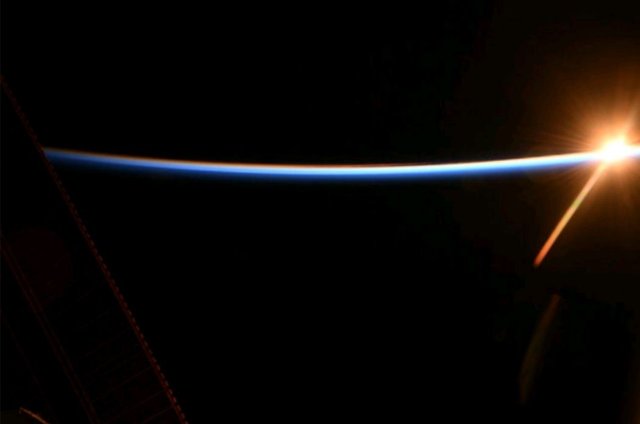
Credit: JAXA/Norishige Kanai
Supermoon Rings In 2018!
The biggest full moon of 2018 lit up the night sky overnight on Jan. 1 and 2, thrilling skywatchers around the world. Here, the bright moon rises behind the Empire State Building in New York City in this spectacular photo by Alexander Krivenyshev of WorldTimeZone.com taken on Jan. 1, 2018. Krivenyshev took the photo from Hoboken, New Jersey, across the Hudson River.
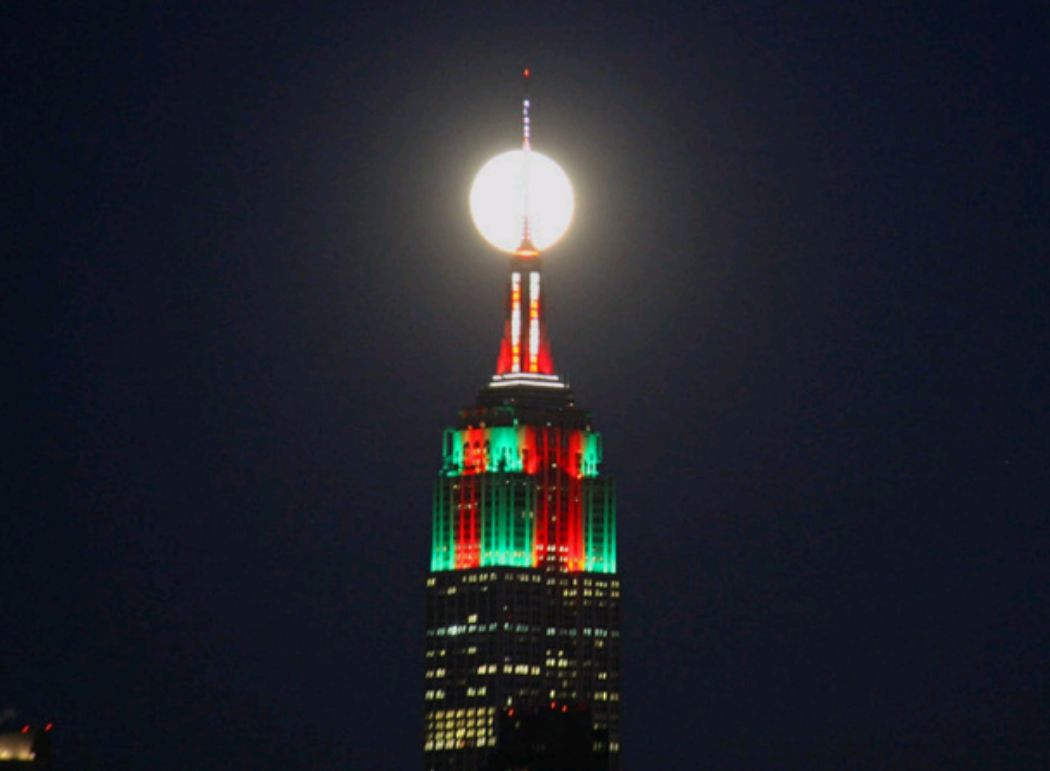
Credit: Alexander Krivenyshev/WorldTimeZone.com
iii. Strange Dimming Star May Be Scarfing Down Wrecked Planets
Vast orbiting clouds of planetary wreckage could be causing a distant young star's strange dimming behavior, a new study shows.
The star, known as RZ Piscium, is located about 550 light-years away, in the constellation Pisces. Observations of the young sun-like star revealed unpredictable dimming episodes, during which the star becomes as much as 10 times fainter, according to a statement from NASA announcing the findings;
"Our observations show there are massive blobs of dust and gas that occasionally block the star's light and are probably spiraling into it," Kristina Punzi, lead author of the study and a doctoral student at the Rochester Institute of Technology (RIT) in New York, said in the statement. "Although there could be other explanations, we suggest this material may have been produced by the break-up of massive orbiting bodies near the star." Exoplanets That Could Host Alien Life
While studying, the astronomers found that the star's erratic dimming behavior can last as long as two days. Observations also showed that nearly 8 percent of the star's total luminosity is infrared, which is a far larger proportion of infrared radiation than that produced by most other stars, such as our sun. This suggests that an enormous amount of warm dust surrounds the star, according to the NASA statement.
Using the European Space Agency's (ESA) XMM-Newton satellite, the researchers confirmed the star's youth by measuring its X-ray output, which is roughly 1,000 times greater than the X-ray output from our sun, according to the statement — younger stars often release more X-ray radiaton.
Furthermore, ground-based observations from the Shane 3-meter telescope at Lick Observatory in California and the 10-meter Keck I telescope at W. M. Keck Observatory in Hawaii revealed that the surface temperature of the star is approximately 9,600 degrees Fahrenheit (5,300 degrees Celsius), which is only slightly cooler than the surface temperature of the sun. Also, the observations showed traces of lithium, which is slowly destroyed by nuclear reactions inside a star as it ages.
"The amount of lithium in a star's surface declines as it ages, so it serves as a clock that allows us to estimate the elapsed time since a star's birth," study co-author Joel Kastner, director of RIT's Laboratory for Multiwavelength Astrophysics, said in the statement. "Our lithium measurement for RZ Piscium is typical for a star of its surface temperature that is about 30 to 50 million years old."
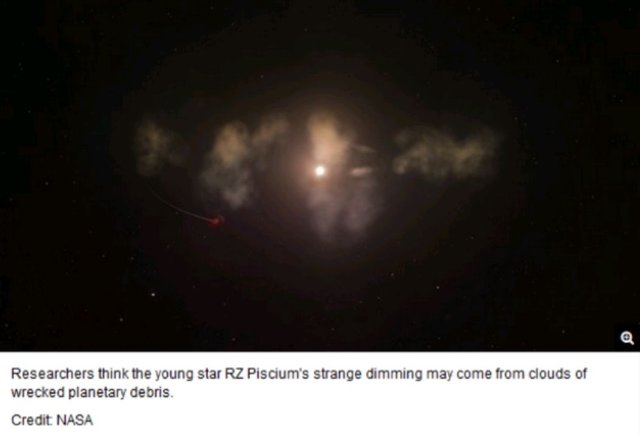
Generally, the disk of planet-forming material surrounding a sun-like star condenses to form planets and moons within a few million years of the star’s birth. However, a large amount of gas and dust still circles RZ Piscium, which suggests the star is destroying planets in its vicinity, rather than building them.
The clouds of debris, which orbit approximately 30 million miles (50 million kilometers) from the star, likely formed following a planetary collision, and RZ Piscium now feeds on the leftover planetary material, according to the statement.
But there's a twist: In addition to the leftover material falling inward toward the star, the observations suggest that some of the dust is also flowing outward from the star, the researchers said.
This indicates that RZ Piscium may exert tidal forces that strip material from a neighboring stellar companion or giant planet. This, in turn, would produce intermittent streams of gas and dust, according to the statement.
"While we think the bulk of this debris is about as close to the star as the planet Mercury ever gets to our sun, the measurements also show variable and rapidly moving emission and absorption from hydrogen-rich gas," study co-author Carl Melis, an associate research scientist at the University of California, San Diego, said in the statement.
Based on their observations, the researchers suggest that the star is gobbling up a large planet. The star’s gravity would ultimately rip the planet to shreds, causing some of the observed bursts in X-rays, the researchers said.
Their findings were published Dec. 21 in The Astronomical Journal.
iv. New Image Reveals Enormous Bubbles Across Red Giant Star's Surface
By Elizabeth Howell, Space Contributor
Astronomers spotted giant bubbles on the surface of a huge red-giant star, showing for the first time the convective cells that move heat around in these enormous objects.
The star is called Pi1 Gruis, and it is 350 times the diameter of our own sun — not to mention, much brighter than Earth's star. Pi1 Gruis is a red giant, a type of object that forms when stars about the mass of the sun run out of hydrogen to burn and therefore swell up. Pi1 Gruis resides about 530 light-years from Earth, in the constellation Grus (the Crane). [How to Tell Star Types Apart (Infographic)]
"When Pi1 Gruis ran out of hydrogen to burn long ago, this ancient star ceased the first stage of its nuclear fusion program. It shrank as it ran out of energy, causing it to heat up to over 100 million degrees Celsius [212 million degrees Fahrenheit]," European Southern Observatory officials said in a statement. The observatory's Very Large Telescope obtained images of the star's surface.
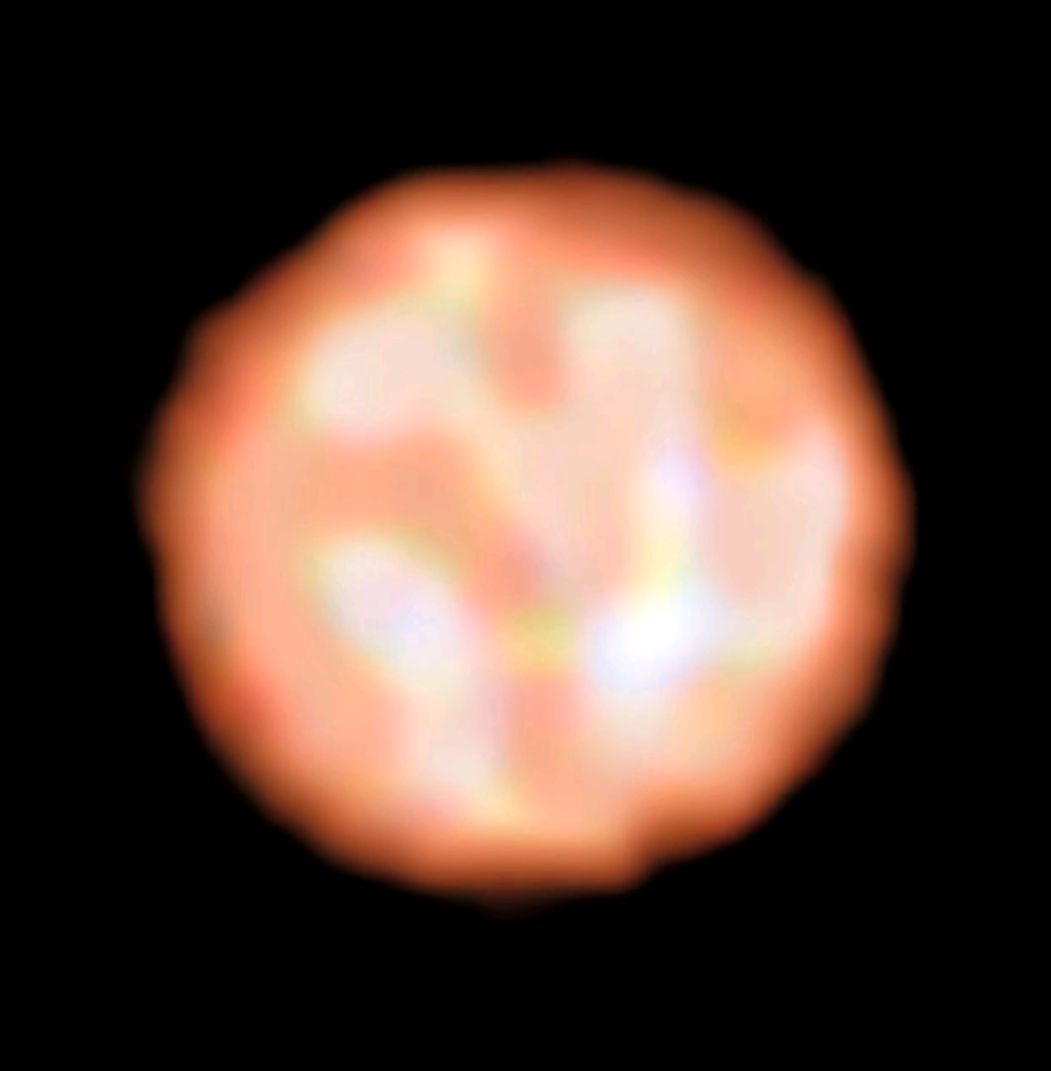
Astronomers used ESO's Very Large Telescope to observe bubbling patterns on the aging red-giant star Pi1 Gruis.
Credit: ESO
"These extreme temperatures fueled the star's next phase as it began to fuse helium into heavier atoms such as carbon and oxygen," ESO officials said. "This intensely hot core then expelled the star's outer layers, causing it to balloon to hundreds of times larger than its original size. The star we see today is a variable red giant. Until now, the surface of one of these stars has never before been imaged in detail."
Pi1 Gruis has a few visible convective cells that are about 75 million miles (120 million kilometers) across. (A convective cell is a region on a star where matter is warmed from the star's internal heat and rises to the surface; on the surface, the material cools since it is close to cold space and then sinks again. This motion cycle is called convection.)
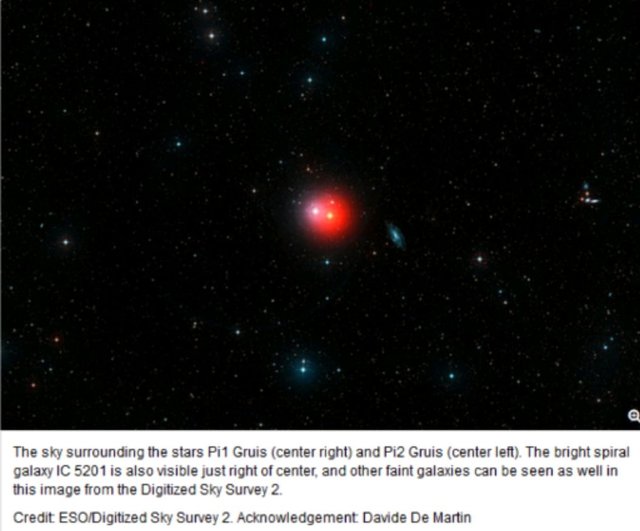
If we were to put one of these convective cells from 1 Gruis in our own solar system, it would extend from the sun to beyond Venus' orbit. Our sun's convective cells, by contrast, are only about 930 miles (1,500 km) across. ESO stated the size difference comes from the stars' different surface gravities. Because Pi1 Gruis has only 1.5 times the mass of the sun but is so much larger, it has a lower surface gravity and only a few, large bubbles.
The observation team, which was led by ESO astronomer Claudia Paladini, noted that it was fortunate that the surface of Pi1 Gruis was visible, because many of the surfaces (or photospheres) of giant stars are blocked by dust. There is dust in the system of Pi1 Gruis, but it's far enough away from the star that this material does not significantly affect observations, the researchers said.
After the red giant phase, stars like Pi1 Gruis and our sun will eventually shed their outer layers and become planetary nebulas. (Stars that explode as supernovas are much larger, at more than eight solar masses.) A previous study of Pi1 Gruis found material located about 0.9 light-years away from the star and ejected roughly 20,000 years ago.
Hi! I am a robot. I just upvoted you! I found similar content that readers might be interested in:
http://ca.pressfrom.com/news/technology/-59134-supersize-stars-may-be-more-common-than-previously-thought/
Thanks